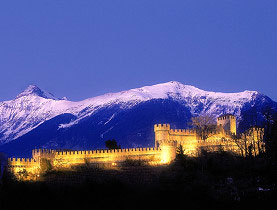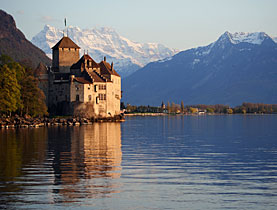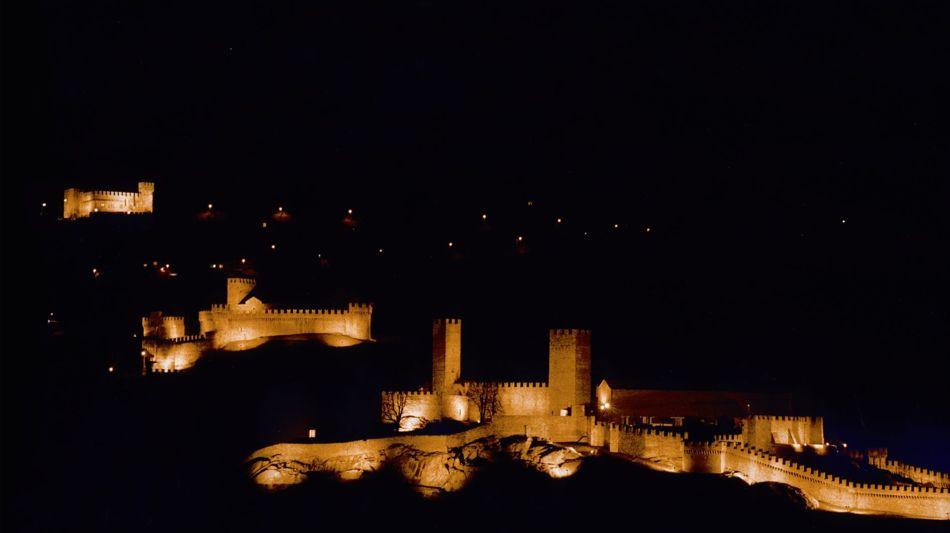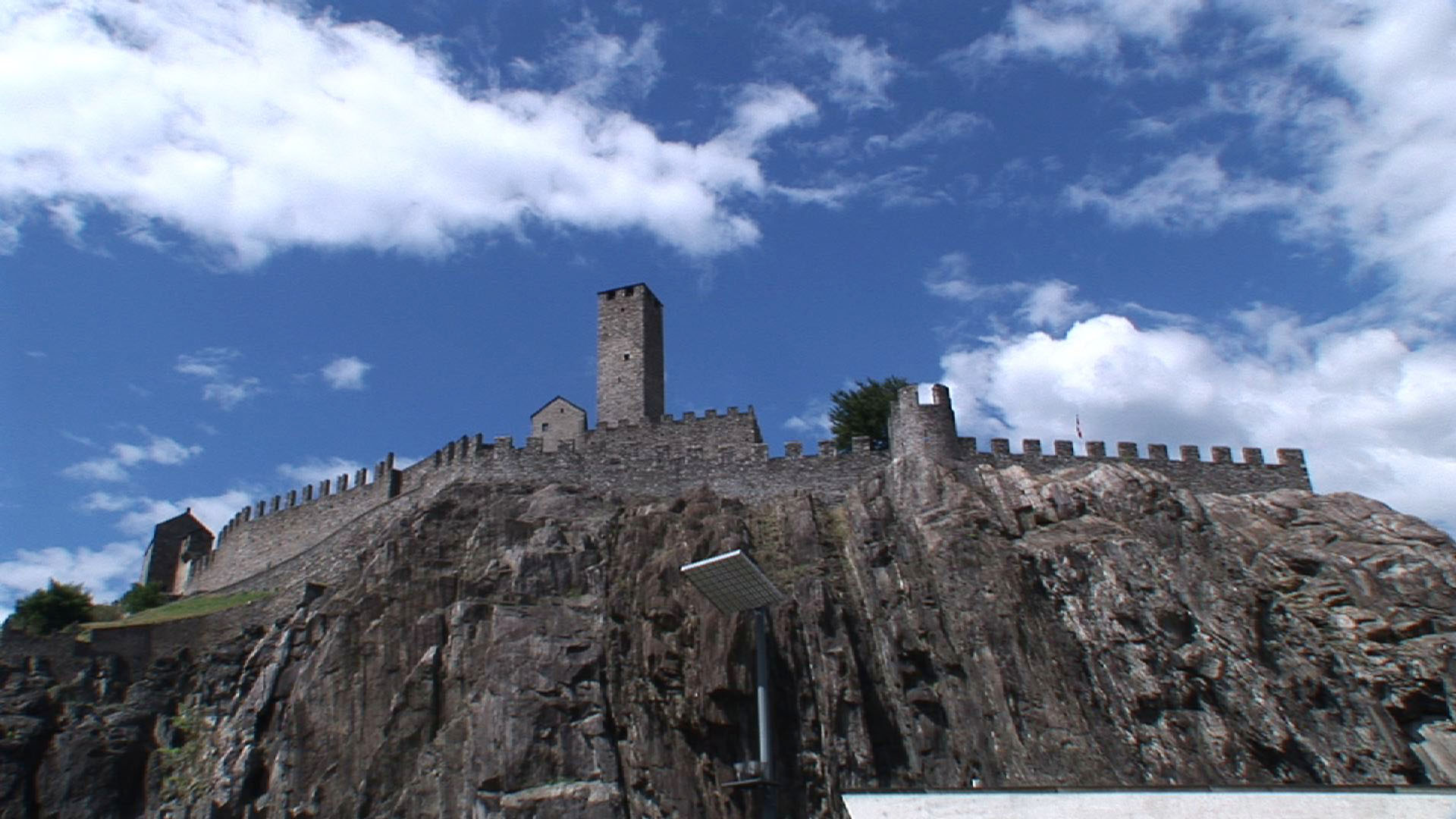Visitors breach Bellinzona’s defences

Bellinzona’s three castles are outstanding examples of fortified medieval architecture – and a major Swiss tourist attraction.
Castelgrande, Montebello, Sasso Corbaro, as well as the town’s defensive wall and ramparts, were added to the Unesco list of World Heritage Sites in 2000.
The town’s complex defensive system was built largely by the Dukes of Milan in the 15th century. They considered Bellinzona as key to the Alpine passes and an essential gateway to Italy.
Franco Ruinelli, director of Bellinzona Tourism in the Italian-speaking southern canton of Ticino, told swissinfo.ch that the Unesco label had not only attracted tourists to the area. It has also led to a revival of interest in local heritage.
“It is as if the people of Ticino, including the local Bellinzonesi, had suddenly rediscovered the castles,” he said.
“There has also been a radical change in the way we see these castles. Their inclusion in the list of World Heritage Sites has also been an opportunity to promote our region, with its cultural assets and values, in a different way,” added Ruinelli.
This renaissance of the ancient castles, now familiar all over the world through new means of communication such as the internet, has also been helped by the fact that two of the three monuments have been restored to their former glory.
Castelgrande, the Old Castle
Brilliantly restructured by Ticino architect Aurelio Galfetti, Castelgrande is the first of the three castles. Over the years, it has been called the Old Castle, Uri Castle and St Michael’s Castle.
Located in the town centre, Castelgrande is a silent and elegant observer of the town’s daily life. At the foot of its craggy walls, in Piazza del Sole, people meet and festivals and concerts are held. It is also the setting for official receptions and international events.
The castle can be reached on foot, or there is a lift set into the rock. The complex comprises a history museum, a restaurant, a wine bar and a multifunctional area. On the north side, the castle is defended by rocky, almost vertical walls.
Montebello, the Middle Castle
The imposing Montebello complex – previously known as Small, New, or Middle Castle in the 14th and 15th centuries, as Schwyz Castle from 1506, and from 1818 as Saint Martin’s Castle – stands on a rocky spur to the east of the town centre. It dates from the late 14th century.
Allowed to fall into a state of disrepair, by 1900 Montebello was in imminent danger of collapse. A major restoration began in 1903 and between 1971 and 1974 the interior was restructured for exhibition purposes.
“The structure of Montebello Castle is very delicate,” explained Ruinelli. “There are plans to carry out further work on the fabric, but they need to be very carefully assessed.”
The castle now houses the Civic Museum and its archaeological collection, featuring artefacts from prehistoric burial sites in the Ticino region. Montebello, which is possibly the most fairytale-like of the three castles, is often the setting for celebrations, and the museum is much visited.
Sasso Corbaro, the Upper Castle
The highest of the three castles, Sasso Corbaro, overlooks Bellinzona. It stands on the highest point of a rocky ridge, immersed in greenery, to the south east of the town. The castle offers an impressive view.
It, too, has changed names over the centuries, previously having been called Untervalden Castle and St Barbara’s Castle.
The project to redevelop the fortification, masterminded by Ticino architect Paola Piffaretti, has restored light and lustre to a building which in 1894 was described as “a ruin on the point of collapse”.
Simple, sober, functional and innovative measures have transformed the edifice, which now houses both a restaurant and exhibition areas. The surrounding landscape is also magnificent. The entire hillside had been tidied up and a network of walking trails has been added.
Town walls and murata
Bellinzona’s defensive wall and ramparts are also impressive. “Unlike other cities, whose fortifications are arranged in concentric circles around the urban nucleus, Bellinzona has two separate sets of walls,” according to Werner Meyer in a guidebook on the subject.
“At either end they rise and join with the defensive structures of Castelgrande and Montebello and are so closely knit that it is difficult to see where the city walls begin and the external castle structures end.”
The original ramparts, sixty per cent of which have survived, have been much altered over the last hundred years for urban redevelopment and to provide access for pedestrians and vehicles.
Connected to the western flank of Castelgrande, and following a natural ridge, is the murata, a mighty defensive wall built to block the valley, which once ran as far as the mountainside on the right bank of the Ticino river.
Meyer says, however, that the wall still bears its secrets. “Unfortunately, over the years, large parts of the murata have been lost, leaving unanswered questions as to the extent and function of the overall defensive system,” he writes.
Françoise Gehring in Bellinzona, swissinfo.ch
The Bellinzona site consists of a group of fortifications grouped around the castle of Castelgrande, which stands on a rocky peak looking out over the entire Ticino valley.
Running from the castle, a series of fortified walls protect the ancient town and block the passage through the valley.
A second castle (Montebello) forms an integral part of the fortifications, while a third but separate castle (Sasso Corbaro) was built on an isolated rocky promontory south-east of the other fortifications.
Source: Unesco

In compliance with the JTI standards
More: SWI swissinfo.ch certified by the Journalism Trust Initiative



You can find an overview of ongoing debates with our journalists here. Please join us!
If you want to start a conversation about a topic raised in this article or want to report factual errors, email us at english@swissinfo.ch.